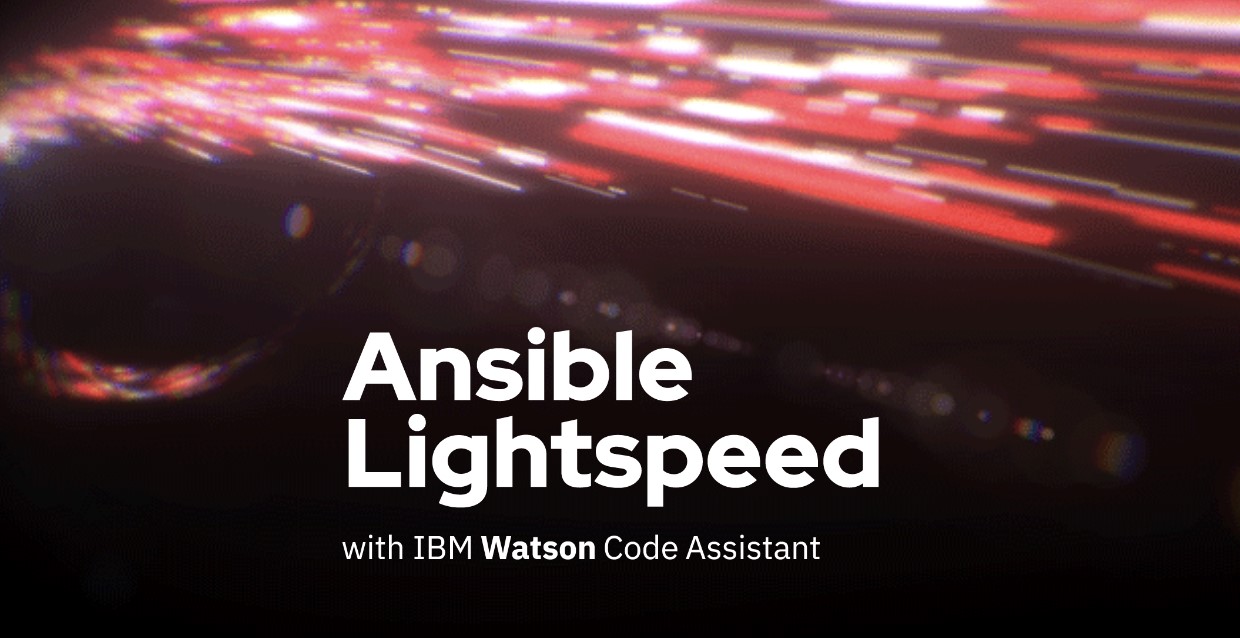Red Hat Launches Red Hat Ansible Lightspeed with IBM watsonx Code Assistant for AI-Driven Enterprise IT Automation
Now generally available, purpose-built AI service delivers a trusted Ansible advisor to help extend and scale automation content across teams with greater efficiency, accuracy and trust
Red Hat, Inc., the world’s leading provider of open source solutions, today announced the general availability of Red Hat Ansible Lightspeed with IBM watsonx Code Assistant, a generative AI service to help enterprises accelerate IT automation across an organization.
According to IDC, “through 2024, shortcomings in critical skills creation and training efforts by IT industry leaders will prevent 65% of businesses from achieving full value from cloud, data, and automation investments.”[1] But, “generative AI has the potential to revolutionize the entire software development life cycle. IDC’s survey of developers about their use of generative AI indicates they see great potential for generative AI to increase productivity and automation for these non-coding tasks. Developers recognize the opportunity for DevOps automation to improve key software quality metrics by automating software testing, scoring project risk, and improving threat modeling.”[2]
Red Hat Ansible Lightspeed generates content recommendations from user prompts, integrating with IBM watsonx Code Assistant to access IBM foundation models and quickly build Ansible content. The service is purpose-built for Ansible, helping users to bridge the gap between automation ideas and Ansible content creation. Not only does this increase automation accessibility across IT personnel, but it also enables content best practices and maintenance organization-wide, resulting in improved, more consistent automation.
Focused automation for real world applications
A purpose-built AI service trained on Ansible data, Ansible Lightspeed with watsonx Code Assistant combines the power of first-hand experience with technical innovation to deliver content recommendations that are more accurate, consistent and specific to business needs. The service also enhances established ways of working as a natural extension of existing Red Hat Ansible Automation Platform workflows and alongside the full suite of Ansible content tools. As part of the Ansible Automation Platform subscription and natively integrated with the Ansible Visual Studio Code extension, developers and operators don’t need to log into or access a separate tool or service to access the potential of Ansible Lightspeed with watsonx Code Assistant.
To create and edit Ansible Playbooks and rules, users can input a straightforward text prompt and receive an output that’s translated into YAML content, streamlining role and playbook creation. Experienced users can significantly boost productivity while novice users have fewer barriers to entry for content creation, helping to expand the aperture of who can create Ansible content while also addressing automation skills gaps across the enterprise.
An emphasis on quality content
Ansible Lightspeed with watsonx Code Assistant helps translate existing subject matter expertise into more compliant Ansible automation content and best practices that scale across teams and the enterprise. Ansible Lightspeed with watsonx Code Assistant scans existing Ansible content to help standardize and improve quality through its recommendations, as well as adhere to industry-standards. The service also helps safeguard private data through data isolation, so sensitive customer information remains untouched and possible data leaks are minimized.
Generative AI, the open source way
In alignment with Red Hat’s open source values, the Ansible Lightspeed with watsonx Code Assistant experience is built on transparency, collaboration and choice. Content source matching offers users visibility into the potential sources, authors and licenses used to train the data for the content recommendations, so contributors are properly recognized for their work and teams can better trust the AI-generated content. In addition, upstream content contributors have a choice as to whether or not their work contributes to fine-tuning of the model.
Availability
Red Hat Ansible Lightspeed is now generally available with your Ansible Automation Platform subscription, with IBM watsonx Code Assistant available for purchase separately. Fine-tuning capabilities to train custom models specific to organizations is expected for customers later this year. For more information and to get started, visit redhat.com/ansible-lightspeed.
Supporting Quotes
Ashesh Badani, senior vice president and Chief Product Officer, Red Hat
“AI offers an immense opportunity for enterprises to accelerate innovation. To help our customers contextualize AI, Red Hat has forged two paths to make it practical and specific to their existing priorities: delivering a foundation for building, tuning and maintaining AI workloads and AI-infused capabilities for our platforms, including Ansible. We’ve already shown what domain-specific AI can do for IT automation at the community level, and the general availability of Ansible Lightspeed with watsonx Code Assistant has the potential to close skills gaps, create greater organizational efficiencies and free enterprise IT to deliver even more business value.”
Keri Olson, vice president, Product Management, IBM watsonx Code Assistant
“AI and IT automation have drastically accelerated innovation across industries, but there are still so many untapped possibilities that we can achieve in technology. The tech preview of Ansible Lightspeed with IBM watsonx Code Assistant gave us a snapshot into what’s possible when we combine domain-specific AI with IT automation.”
Gerry Leitão, leader, Partner and Global Hybrid Cloud Automation, IBM Consulting
“We have seen firsthand that generative AI can act as a force multiplier for developers. During the technical preview for watsonx Code Assistant for Red Hat Ansible Lightspeed, we observed initial build productivity improvements in the range of 20-45%. As we move to GA, even more gains in productivity are expected. We also believe there’s additional downstream productivity that has not been fully quantified yet. Not only are we aiming to accelerate the development phase for Ansible automations and shorten time-to-value for our clients after GA, but we intend for the quality of the content to be higher.”[3]
Lara Greden, research director, Platform as a Service (PaaS) and Brijesh Kumar, senior research analyst, Cloud Application Development Platforms, IDC
“Automation is one laser-focused area in which cloud vendors are investing their time and enhancing the capabilities of their existing tools and platforms. Adding AI-based features further increases the benefits and business value of these solutions and provides a competitive edge in the market. With AI capabilities in Red Hat Ansible Lightspeed, the company is focusing on a strong problem to solve for customers.”[4]
[1] IDC FutureScape: Worldwide IT Industry 2023 Predictions, Doc #US49563122, Oct 2022
[2] IDC, Generative AI: The Path to Impact, Doc #EUR151153223, Aug 2023
[3] IBM Consulting, Transforming the way developers learn and work, Oct 2023
[4] IDC, Red Hat’s Focus on Serving Developers and Being the Platform for the AI-Everywhere Future, Doc #US50790123, Jun 2023


